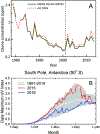Environmental effects of ozone depletion, UV radiation and interactions with climate change: UNEP Environmental Effects Assessment Panel, update 2017
- PMID: 29404558
- PMCID: PMC6155474
- DOI: 10.1039/c7pp90043k
Environmental effects of ozone depletion, UV radiation and interactions with climate change: UNEP Environmental Effects Assessment Panel, update 2017
Abstract
The Environmental Effects Assessment Panel (EEAP) is one of three Panels of experts that inform the Parties to the Montreal Protocol. The EEAP focuses on the effects of UV radiation on human health, terrestrial and aquatic ecosystems, air quality, and materials, as well as on the interactive effects of UV radiation and global climate change. When considering the effects of climate change, it has become clear that processes resulting in changes in stratospheric ozone are more complex than previously held. Because of the Montreal Protocol, there are now indications of the beginnings of a recovery of stratospheric ozone, although the time required to reach levels like those before the 1960s is still uncertain, particularly as the effects of stratospheric ozone on climate change and vice versa, are not yet fully understood. Some regions will likely receive enhanced levels of UV radiation, while other areas will likely experience a reduction in UV radiation as ozone- and climate-driven changes affect the amounts of UV radiation reaching the Earth's surface. Like the other Panels, the EEAP produces detailed Quadrennial Reports every four years; the most recent was published as a series of seven papers in 2015 (Photochem. Photobiol. Sci., 2015, 14, 1-184). In the years in between, the EEAP produces less detailed and shorter Update Reports of recent and relevant scientific findings. The most recent of these was for 2016 (Photochem. Photobiol. Sci., 2017, 16, 107-145). The present 2017 Update Report assesses some of the highlights and new insights about the interactive nature of the direct and indirect effects of UV radiation, atmospheric processes, and climate change. A full 2018 Quadrennial Assessment, will be made available in 2018/2019.
Conflict of interest statement
Conflicts of interest
The opinions expressed in this report are those of the authors alone. Richard Zepp notes that this Perspective article has been reviewed in accordance with the U.S. Environmental Protection Agency’s (U.S. EPA) peer and administrative review policies and approved for publication. Mention of trade names or commercial products does not constitute an endorsement or recommendation for use by the U.S. EPA.
Figures













References
-
- Chipperfield MP, Bekki S, Dhomse S, Harris NRP, Hassler B, Hossaini R, Steinbrecht W, Thiéblemont R and Weber M, Detecting recovery of the stratospheric ozone layer, Nature, 2017, 549, 211–218. - PubMed
-
- Hu L, Montzka SA, Lehman SJ, Godwin DS, Miller BR, Andrews AE, Thoning K, Miller JB, Sweeney C, Siso C, Elkins JW, Hall BD, Mondeel DJ, Nance D, Nehrkorn T, Mountain M, Fischer ML, Biraud SC, Chen H and Tans PP, Considerable contribution of the Montreal Protocol to declining greenhouse gas emissions from the United States,Geophys. Res. Lett, 2017, 44, 8075–8083.
-
- Hurwitz MM, Fleming EL, Newman PA, Li F and Liang Q, Early action on HFCs mitigates future atmospheric change, Environ. Res. Lett, 2016, 11, 114019.
-
- Xu Y, Zaelke D, Velders GJM and Ramanathan V, The role of HFCs in mitigating 21st century climate change, Atmos. Chem. Phys, 2013, 13, 6083–6089.
Grants and funding
LinkOut - more resources
Full Text Sources
Other Literature Sources

